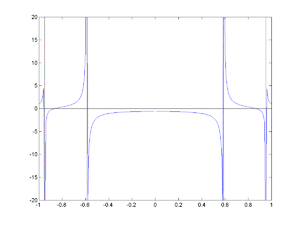Cauchy index
In mathematical analysis, the Cauchy index is an integer associated to a real rational function over an interval. By the Routh–Hurwitz theorem, we have the following interpretation: the Cauchy index of
- r(x) = p(x)/q(x)
over the real line is the difference between the number of roots of f(z) located in the right half-plane and those located in the left half-plane. The complex polynomial f(z) is such that
- f(iy) = q(y) + ip(y).
We must also assume that p has degree less than the degree of q.
Definition
- The Cauchy index was first defined for a pole s of the rational function r by Augustin Louis Cauchy in 1837 using one-sided limits as:
- A generalization over the compact interval [a,b] is direct (when neither a nor b are poles of r(x)): it is the sum of the Cauchy indices
 of r for each s located in the interval. We usually denote it by
of r for each s located in the interval. We usually denote it by  .
.
- We can then generalize to intervals of type
![[-\infty,+\infty]](../I/m/936cbe1fb6394ff85b26a5e76e81fcd5.png) since the number of poles of r is a finite number (by taking the limit of the Cauchy index over [a,b] for a and b going to infinity).
since the number of poles of r is a finite number (by taking the limit of the Cauchy index over [a,b] for a and b going to infinity).
Examples

- Consider the rational function:
We recognize in p(x) and q(x) respectively the Chebyshev polynomials of degree 3 and 5. Therefore r(x) has poles  ,
,  ,
,  ,
,  and
and  , i.e.
, i.e.  for
for  . We can see on the picture that
. We can see on the picture that  and
and  . For the pole in zero, we have
. For the pole in zero, we have  since the left and right limits are equal (which is because p(x) also has a root in zero).
We conclude that
since the left and right limits are equal (which is because p(x) also has a root in zero).
We conclude that  since q(x) has only five roots, all in [−1,1]. We cannot use here the Routh–Hurwitz theorem as each complex polynomial with f(iy) = q(y) + ip(y) has a zero on the imaginary line (namely at the origin).
since q(x) has only five roots, all in [−1,1]. We cannot use here the Routh–Hurwitz theorem as each complex polynomial with f(iy) = q(y) + ip(y) has a zero on the imaginary line (namely at the origin).

